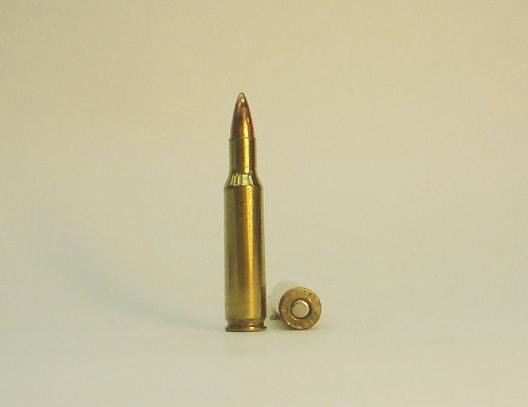Designer Mike Walker Manufacturer Remington | Designed 1950 Case type Rimless, bottleneck | |
 | ||
The .222 Remington, which is also known as the Triple Deuce/Triple Two/Treble Two is a centerfire rifle cartridge. Introduced in 1950, it was the first commercial rimless .22 (5.56 mm) cartridge made in the United States. As such, it was an entirely new design, without a parent case. The .222 Remington was a popular target cartridge from its introduction until the mid-1970s and still enjoys a reputation for inherent accuracy. It remains a popular vermin cartridge at short and medium ranges with preferred bullet weights of 40-55 grains and muzzle velocities from 3000-3500 fps.
Contents
Introduction
The .222 Remington was introduced in the Remington Arms Model 722 bolt action rifle. Factory rifles often produce groups of one minute of arc (0.3 mrad) or less with no tuning. The accuracy and flat trajectory of the cartridge resulted in the adoption of the round for varmint and benchrest rifles. The faster .220 Swift and .22-250 Remington provided more reach than the .222 Remington. These larger cartridges have more power (roughly 50 percent more) than the .222, but also more muzzle blast and barrel erosion.
The .222 Remington is popular in Europe where it is known as 5.7×43. Sako was one of the first European makers to introduce .222 Remington rifles and cartridges, and German and Austrian hunters quickly adopted the .222 Remington for hunting smaller deer sized game.
Legacy
The .222 Remington was finally eclipsed in benchrest competition by the 6mm PPC.
When the US military was looking for a new smallbore rifle cartridge, Remington started with the .222 Remington, and stretched it to increase powder capacity by about 20% in 1958 to make the .222 Remington Magnum. The greater powder capacity put the velocities between the standard .222 Remington and the .22-250. The cartridge was not accepted by the military, but it was introduced commercially. In 1963, the 5.56×45mm NATO, also based on a stretched .222 case, was adopted along with the new M16 rifle. The NATO cartridge had a capacity only 5% less than the Magnum. The new 5.56×45mm cartridge was commercialized by Remington as the .223 Remington. Given the close performance to other cartridges and military acceptance, both the .222 Remington and the .222 Magnum faded quickly into obsolescence, being replaced by the .223 Remington.
While the .222 Remington is rarely found in current production in America, its derivative cartridges are among the most popular in the world. In addition to the .222 Magnum and .223 Remington, the .222 has also served as the parent case for the .221 Fireball, the fastest production handgun cartridge.
The .222 Remington still is fairly popular in Europe, where producers like Sako, Tikka and Sauer chamber rifles for this caliber. Firearms that are usually chambered for the .223 Remington/5.56×45mm NATO caliber are often rechambered for the .222 Remington for sale in countries where regulations restrict or forbid civilian ownership of "military calibers". Examples of countries with such legislation include France and Spain.
